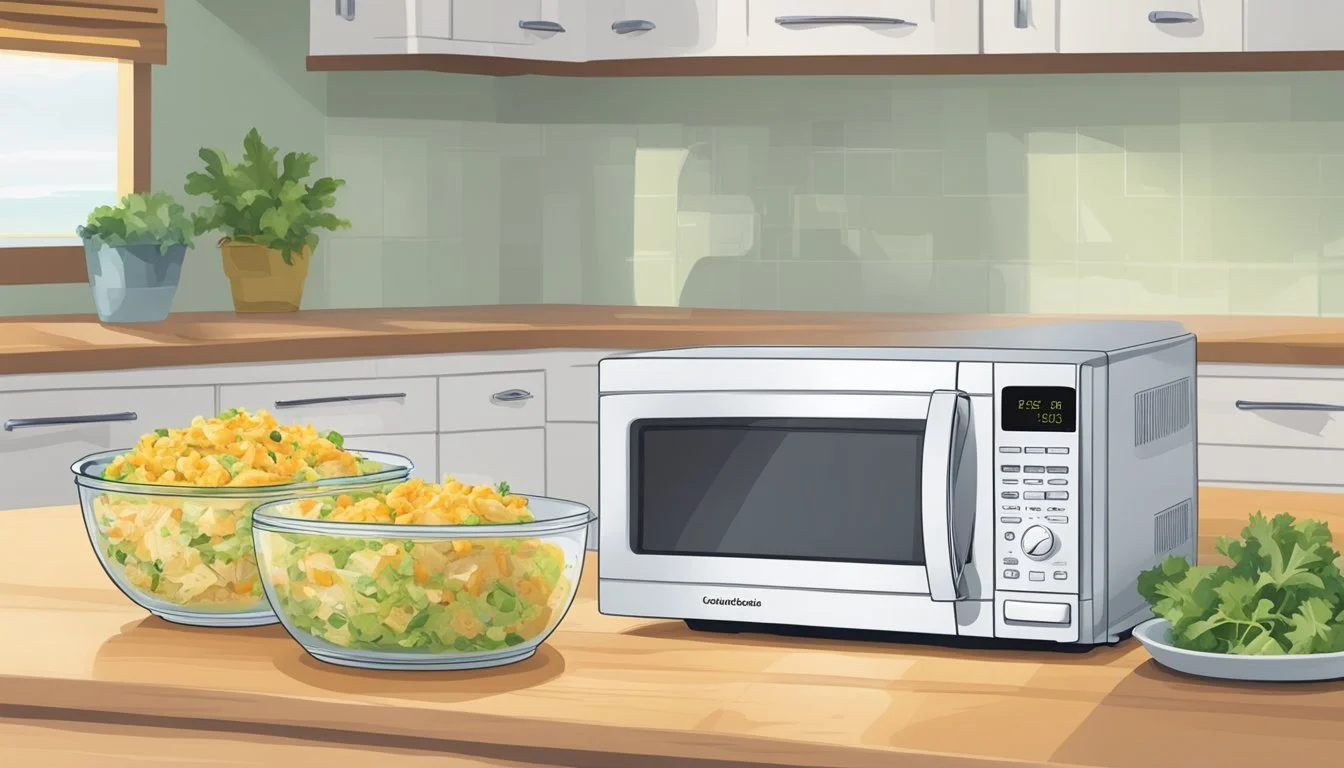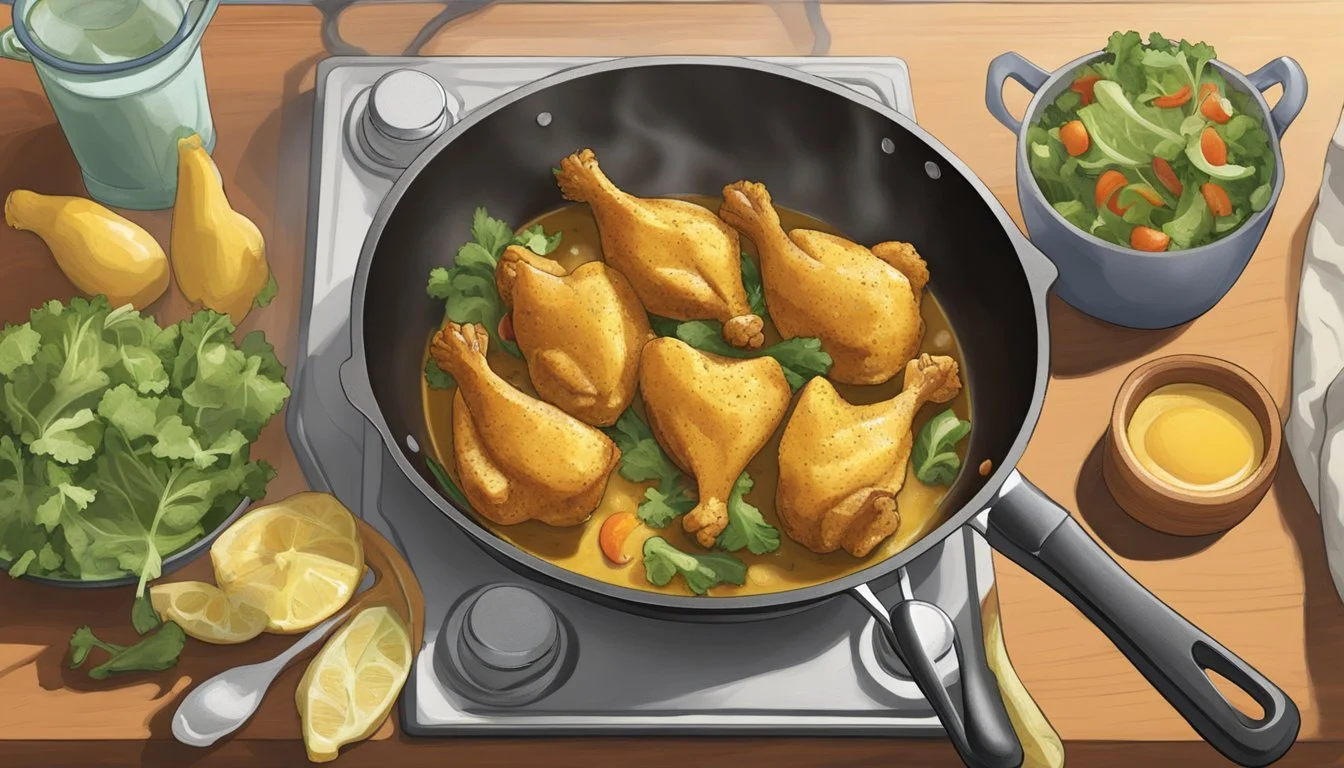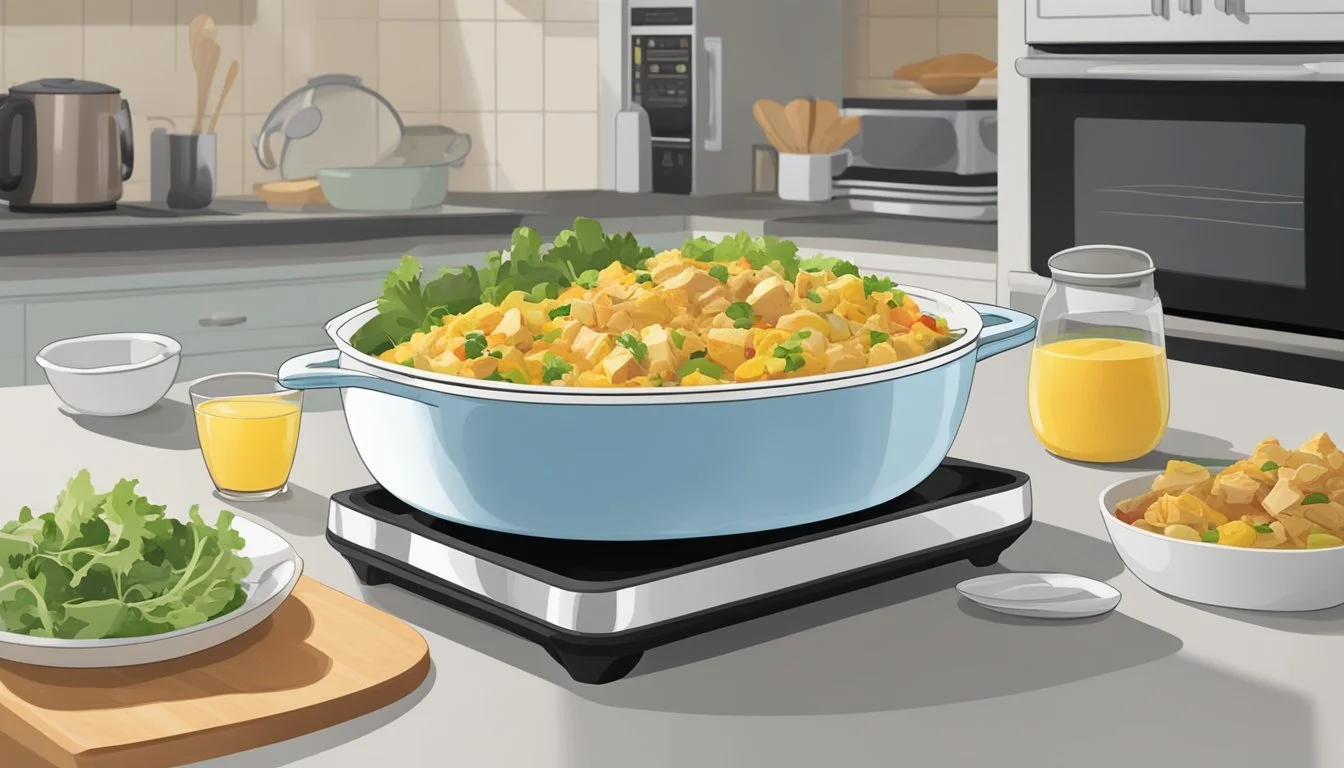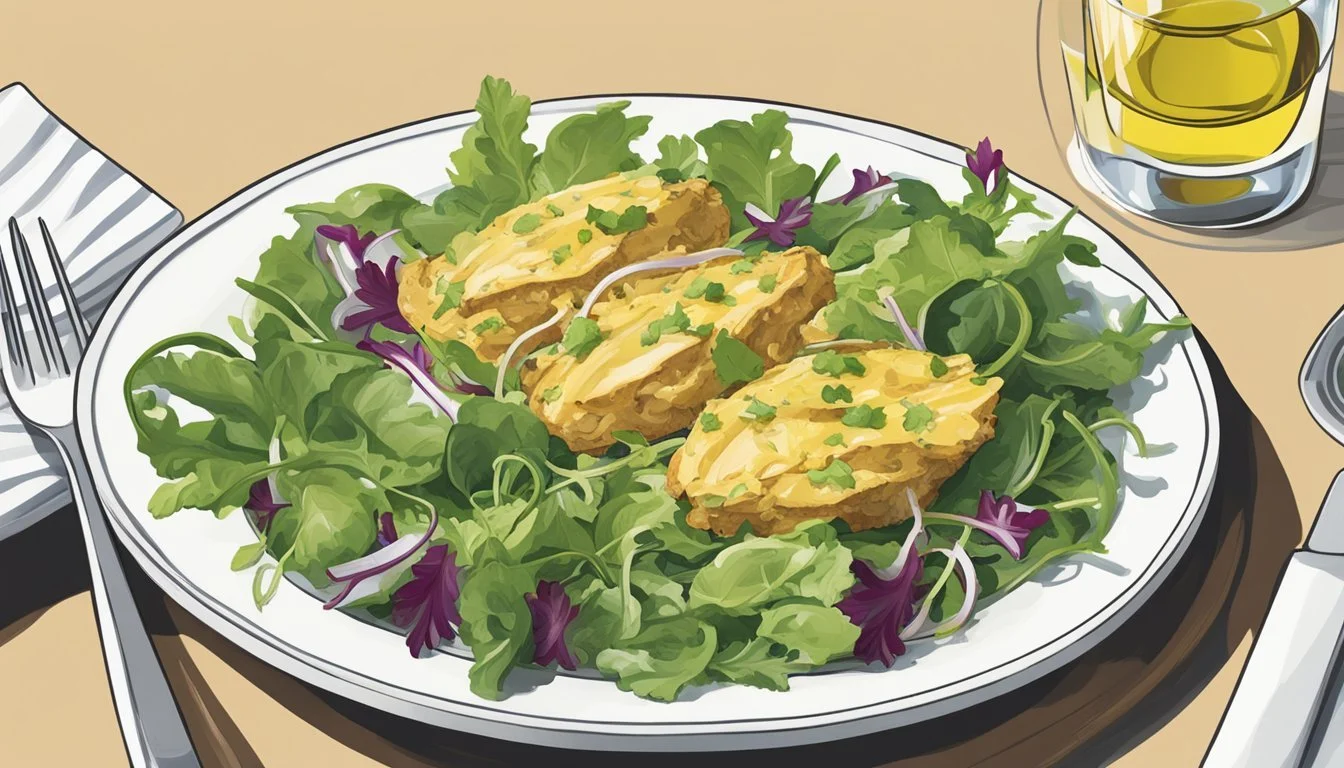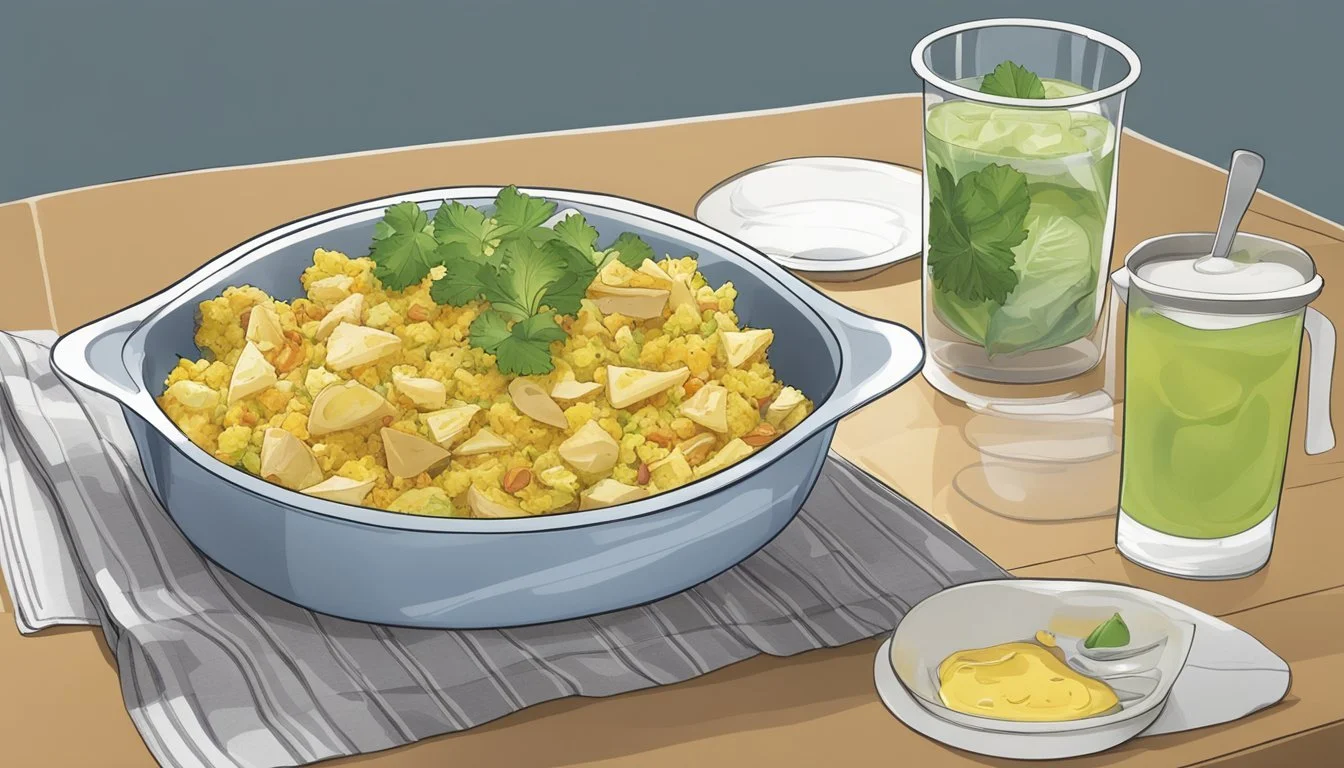Best Way to Reheat Curried Chicken Salad
Keeping It Flavorful and Dry
Reheating curried chicken salad presents a unique challenge: maintaining the dish's creamy texture without adding excess moisture that can result in a watery outcome. Thermal consistency is key to preserving the integrity of the flavors and the desirable consistency of the salad. As such, careful heating methods need to be employed to ensure that the chicken stays moist and the sauce retains its richness without becoming diluted.
One effective method involves using minimal heat to gently warm the chicken without affecting the overall composition of the salad. This technique avoids the reintroduction of excess liquid, which is often the culprit in turning a perfectly seasoned curried chicken salad into a less appealing, watery dish. Uniform heating is also crucial to protect the delicate balance of spices that characterize the dish, keeping the aromatic profile intact.
In addition, understanding the elements of the salad, such as the mayonnaise-based dressing, plays an important role in selecting the best reheating approach. The stability of such dressings under heat must be considered to prevent separation, which could alter both texture and flavor. By applying these principles, the curried chicken salad can be reheated to a satisfactory temperature, preserving its original taste and enjoyable creaminess.
Understanding the Basics of Reheating Chicken
When reheating chicken, it's crucial to maintain its flavor and moisture while ensuring it's safe to eat. Proper technique and temperature are key.
The Importance of Internal Temperature
Reheating chicken to the correct internal temperature is essential for food safety. The chicken should reach an internal temperature of 165°F to eliminate any potential bacteria. When using a food thermometer, insert it into the thickest part of the chicken to get an accurate reading. This temperature guideline applies to all methods of reheating chicken, whether on the stove, in an oven, or using a microwave.
Refrigeration and Storage Practices
Before reheating chicken, how it's stored in the fridge plays a significant role in its quality. Leftover chicken should be stored in an airtight container and refrigerated within two hours of cooking. Refrigeration temperature should be set below 40°F to prevent bacterial growth. When stored properly, refrigerated cooked chicken can last for 3-4 days. Always ensure chicken is sealed tightly to prevent moisture loss, which is vital when reheating to avoid dryness.
Preparation for Reheating Curried Chicken Salad
Successfully reheating curried chicken salad ensures a warm meal without compromising its texture or flavor. The key is to retain the salad’s moisture without making it watery.
Choosing the Right Reheating Method
When reheating curried chicken salad, one must select a method that gently warms the dish while preserving its integrity. The oven and microwave are two common kitchen appliances for this purpose.
Oven: The oven provides even heating, ideal for bringing cooked chicken up to temperature without drying it out. To use the oven, one should preheat it to a low temperature, typically around 325°F (163°C), which warms the chicken steadily.
Microwave: A microwave is convenient for quick reheating. Users should opt for a reduced power setting to avoid overheating and making the salad oily or affecting its texture.
Pre-Reheating Preparations
Before reheating curried chicken salad, a preparatory step is essential to ensure even warming and to maintain moisture.
Oven:
Preheat the oven to the recommended temperature.
Arrange the salad in an oven-safe dish and consider adding a splash of sauce to keep it moist.
Cover the dish with aluminum foil to trap steam and prevent dryness.
Microwave:
Place the curried chicken salad in a microwave-safe dish.
If the salad appears dry, lightly drizzle oil or add sauce to reintroduce moisture.
Use a microwave-safe lid or plastic wrap with vents to allow for steam release and to preserve the salad's moisture.
In both methods, it is imperative to avoid over-reheating, as high temperatures can break down the delicate components of the salad, resulting in an unappetizing texture.
Reheating Curried Chicken in the Oven
Reheating curried chicken in the oven can maintain its moisture and enhance flavors if done correctly. The key is to prevent dryness while achieving even cooking.
Oven Method Step-by-Step
Preheat the oven to 350°F (180°C), which is a suitable temperature to warm the chicken without overcooking it.
Place the curried chicken on a baking sheet to allow heat to circulate, which aids in even cooking.
If the curried chicken salad includes a sauce component, separate it before reheating to avoid sogginess. Reheat the chicken and sauce separately if needed.
Cover the chicken with foil to lock in moisture and prevent the top from becoming overly crispy.
Heat for about 10 to 15 minutes. Use a thermometer to check that the internal temperature of the chicken reaches 165°F (74°C), ensuring it is heated thoroughly.
Tips for Avoiding Dryness
Add a bit of liquid: Lightly drizzle the chicken with some broth or water before covering it with foil to help maintain its moisture during reheating.
Avoid overcooking: Keep an eye on the time and temperature to prevent drying out the chicken. Overheating can cause the meat to toughen.
Rest the chicken: Let the chicken sit for a few minutes after reheating. This allows the juices to redistribute, ensuring every bite is moist.
Using the oven to reheat curried chicken, when done with attention to these details, results in a meal that retains its original taste and texture.
Reheating Curried Chicken in the Microwave
Reheating curried chicken in the microwave can be quick and convenient while maintaining the dish's moisture and flavor when done properly. The following steps ensure the chicken is heated evenly without becoming watery.
Microwave Method Step-by-Step
Preparation: Begin by placing the curried chicken salad on a microwave-safe plate. If the chicken is in larger pieces, it's best to cut them into smaller portions for more uniform reheating.
Add Liguid: If the chicken appears dry, add a small amount of liquid, such as water or broth, to preserve moisture. Just a tablespoon or two should suffice to keep it soft without making it watery.
Cover and Reheat: Lightly cover the plate with a microwave-safe lid or a damp paper towel. This will help to retain moisture during reheating.
Set the Microwave: Heat on low power for one minute. Low power is crucial as it helps to reheat the chicken gently without overcooking it or drying it out.
Check and Stir: After the first minute, carefully remove the plate (it may be hot), stir the curry, and spread it out evenly. This step is important to ensure even heating.
Additional Heating: If needed, return to the microwave for additional 15-second intervals, checking the temperature each time until the curried chicken reaches the desired warmth.
Ensuring Even Cooking
Placement: Position larger pieces towards the edge of the plate and smaller pieces in the center where the microwave energy is less intense.
Stirring: Halfway through the reheating process, pause to stir the chicken salad to facilitate even heat distribution.
Temperature Check: A food thermometer can be used to check that the chicken has reached a safe internal temperature of 165°F (74°C).
By following these detailed steps, one can efficiently reheat curried chicken salad in the microwave while maintaining its taste and texture.
Reheating Curried Chicken on the Stovetop
When reheating curried chicken on the stovetop, one must focus on preserving the moisture and texture to maintain flavor without making the salad watery.
Stovetop Method Step-by-Step
Preparation: Begin with a non-stick skillet on the stovetop. The skillet should provide ample space for the chicken to reheat evenly without overcrowding.
Adding Liquid: Pour a small amount of oil or water into the skillet—enough to lightly coat the bottom—and heat it over a medium setting to create a moist environment.
Reheating Process: Once the skillet is warm, add the curried chicken. Heat the chicken gently, stirring regularly, allowing the heat to distribute evenly without boiling the sauce.
Temperature Check: Reheat the chicken until it reaches a safe internal temperature of 165°F. This ensures that the chicken is heated thoroughly for safe consumption.
Maintaining Chicken Texture
Continuous Stirring: To retain the curried chicken's texture, stir the chicken frequently and gently during the reheating process. This prevents the chicken from sticking to the skillet and overcooking, which can lead to a dry texture.
Heat Control: Keep the heat at a medium to low level. High heat can toughen the chicken, whereas lower heat assists in maintaining the desired succulent texture.
By following these steps and paying attention to the quality of heat and movement in the skillet, the curried chicken salad will reheat to the perfect temperature with its moisture, flavor, and texture intact.
Other Reheating Methods
In addition to traditional methods, there are alternative techniques to reheat curried chicken salad that can maintain its moisture and flavor. These methods carefully control heat distribution to avoid a watery outcome.
Using an Air Fryer
An air fryer provides a rapid and even reheating method that circulates hot air around the food. To reheat curried chicken salad in an air fryer:
Preheat the air fryer to 350°F (175°C).
Place leftovers in the air fryer basket, ensuring pieces are not overcrowded to allow for proper air circulation.
Heat for 3-4 minutes or until the chicken reaches an internal temperature of 165°F (74°C).
Check the moisture level; if it appears dry, a light spritz of oil can help retain moisture.
Broth Reheating Technique
Utilizing chicken broth can reintroduce moisture into the chicken, enhancing the flavor without dilution. Here’s how to apply the broth reheating technique:
In a pan, bring a small amount of chicken broth to a gentle simmer.
Add the curried chicken salad and stir gently to incorporate the broth.
Reheat until it's thoroughly warmed, achieving the safe internal temperature of 165°F.
The broth technique helps ensure the chicken remains moist rather than becoming watery.
Safety Considerations When Reheating Chicken
Reheating chicken, particularly in dishes like curried chicken salad, requires precision to avoid foodborne illnesses. Proper handling and achieving the correct internal temperature are crucial.
Avoiding Food Borne Illnesses
When reheating chicken, one must be vigilant to eliminate harmful bacteria that can cause foodborne illnesses. Reheating leftover chicken to the right temperature is the most effective method to ensure safety. Here are the specific steps:
Reheat thoroughly: Chicken should be heated until it reaches an internal temperature of at least 165°F (74°C). This temperature is critical for killing potentially harmful bacteria.
Use a meat thermometer: To confirm that chicken has reached a safe internal temperature, always use a meat thermometer. Insert the thermometer into the thickest part of the meat without touching the bone for an accurate reading.
Avoid uneven reheating: When microwaving, stir the chicken salad occasionally to ensure even distribution of heat throughout the dish.
By following these guidelines, one can confidently enjoy their reheated chicken curry salad without compromising on safety.
Serving and Pairing Reheated Curried Chicken Salad
When serving curried chicken salad that has been reheated, one should consider dishes that complement its rich flavors without overwhelming them. Here are suggestions for dishes and freshness enhancements for an ideal meal combination.
Accompanying Dishes
Pasta Dish: A simple, light pasta dish dressed with olive oil and herbs can balance the hearty curry flavor of the chicken salad.
Vegetables: Steamed or sautéed vegetables such as green beans or bell peppers provide a nutritious and colorful side without competing for attention.
Prawn: Grilled prawns make for a high-protein addition that maintains the dish's sophistication.
Dish Type Suggested Pairing Pasta Olive oil and herb-based sauce Vegetables Green beans, bell peppers Seafood Grilled prawns
Adding Freshness to Reheated Dish
Vegetable Crunch: Freshly sliced cucumbers or radishes can be added to restore a crunchy texture.
Salad Leaves: A side of mixed green leaves, like arugula or spinach, offers a contrasting texture and a fresh palate cleanser between bites of the curried chicken salad.
To ensure that the flavor of the curried chicken salad remains the star, one should introduce additional components judiciously. A sprinkle of fresh herbs or a light squeeze of lemon can lift the dish and contribute flavor without dominating it.
Final Tips and Common Mistakes to Avoid
To ensure curried chicken salad is reheated to perfection, one must consider the method and the common pitfalls associated with reheating. The goal is to maintain the dish's texture and flavor without it becoming watery or rubbery.
Reheating Takeaway Curry
Temperature Control: When reheating takeaway chicken curry, it’s crucial to set the stove or microwave to a medium temperature. Overheating can cause the curry to become watery and affect the texture of the chicken.
Methodology:
Stovetop: Gently simmer the curry, stirring frequently to avoid sticking and to ensure even heating.
Microwave: Use a microwave-safe container, cover with a lid or microwave-safe wrap to trap moisture, and reheat in short intervals, stirring in between.
Common Mistakes:
Avoid sealing the container too tightly when using a microwave, as this can build up excess steam and water down the curry.
Do not rush the reheating process by setting a high temperature, which can lead to rubbery chicken and an unevenly warmed curry.
Preserving Quality of Leftover Curried Chicken
Storage: Leftovers should be stored in the refrigerator within two hours of cooking. For longer preservation, one can freeze the curried chicken using airtight containers or freezer bags.
Reheating:
Oven Method: Place the curried chicken on a baking sheet in the oven. Heat at a low temperature to help preserve the moisture and texture of the chicken.
Microwave: If a microwave is used, sprinkle some water over the chicken before reheating to maintain moisture.
Texture Preservation:
For breaded or fried chicken, reheat in the oven to keep the exterior crisp. A microwave might make the coating soggy.
Chicken should be heated to an internal temperature of 165°F to ensure it’s safe to consume without overcooking it.
Common Mistakes:
Never refreeze thawed chicken curry as it can alter the texture and flavor dramatically.
Reheating curried chicken salad in the oven or microwave until "steaming hot" tends to overcook the chicken and make it rubbery; it’s better to heat it just until it’s warm enough to eat.
By applying these tips carefully, one can enjoy a reheated curried chicken salad that retains its original taste and texture, giving the dish a second life that is almost as good as when it was freshly made.
Conclusion
Reheating curried chicken salad requires careful attention to retain the dish's texture and flavor without adding excess moisture. One should first separate the chicken from the salad. To reheat the chicken, they might consider using a stovetop method, where the chicken is gently heated in a pan with a small amount of oil to prevent drying out. Alternatively, they can opt to oven-heat the chicken at a low temperature, covered with foil to retain moisture.
After reheating the chicken, it can be remixed with the cold salad components. This technique ensures that the crispness of the vegetables is preserved, and the overall salad does not become watery. It is essential to avoid microwave reheating as it can unevenly warm the dish and introduce unwanted moisture.
One must also account for the dressing; if possible, separate the dressing before reheating and then reintroduce it after the chicken is heated. This avoids watering down the salad and maintains a robust and fresh flavor profile.
Key Points for Reheating Curried Chicken Salad:
Separate the chicken from the salad before reheating.
Gently reheat the chicken on the stovetop or in the oven.
Avoid the microwave to prevent sogginess.
Recombine the warm chicken with the cold components after reheating.
Add the dressing post-reheating to maintain optimal flavor.
Even as leftovers, one can enjoy curried chicken salad that closely resembles its original taste and texture by applying these careful reheating methods.



